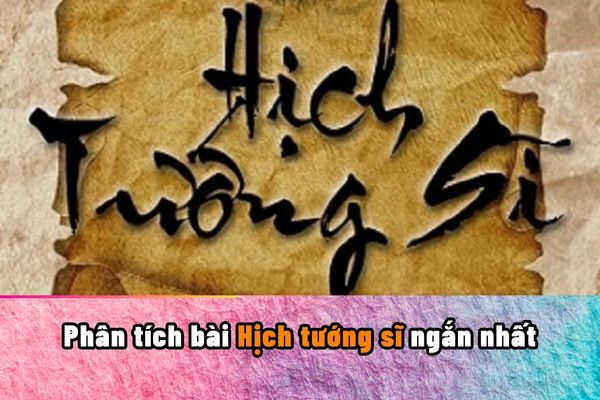What are guidelines on preparing the lesson "Hịch tướng sĩ" for students in Vietnam? What are the required requirements in the reading comprehension section of the grade 8 Literature curriculum in Vietnam?
What are guidelines on preparing the lesson "Hịch tướng sĩ" for students in Vietnam?
"Hịch Tướng Sĩ" is one of the contents that students will study in the grade 8 Literature program.
Students can refer to the following guidelines on preparing the lesson "Hịch tướng sĩ":
|
Analysis of the Essay "Hịch Tướng Sĩ" The essay "Hịch Tướng Sĩ" by Tran Quoc Tuan is a magnificent piece of writing, boiling with patriotic fervor, showcasing both the military and literary talents of the accomplished general. The proclamation is not only a call to action but also a work of art with profound historical and literary value. |
*Note: The above information is for reference only./.

What are guidelines on preparing the lesson "Hịch tướng sĩ" for students in Vietnam? What are the required requirements in the reading comprehension section of the grade 8 Literature curriculum in Vietnam? (Image from the Internet)
What are general direction on the teaching method of grade 8 Literature in Vietnam?
Based on the general education curriculum for the subject of Literature, issued with Circular 32/2018/TT-BGDDT, the teaching method for grade 8 literature is generally oriented as follows:
The Literature program utilizes education methods oriented towards integrated and differentiated teaching; diversifying organizational forms, methods, and teaching tools; promoting students' activeness, proactivity, creativity, and application of knowledge and skills.
Based on the program, teachers actively and flexibly construct and organize lessons according to the following guidelines:
- Implement the requirement of intra-subject integration (both knowledge and skills), cross-subject and instructional integration prioritizing educational contents (transversal); implement differentiated teaching according to student groups at all grades and contribute to occupational orientation at high school.
- Train students in reading, writing, speaking, and listening methods; practice, experience receiving and applying Vietnamese language and literature knowledge through various in-class and extracurricular activities; emphasize using teaching tools, overcome the dictation teaching style, develop thinking, train skills using facilities for students.
- Strengthen and promote students' independence; allocate ample time for students to research textbooks and study materials, exercise, practice, present, discuss, defend study results so that students learn how to read, write, speak, and listen to varying requirements and levels; monitor, assess the implementation of students' learning tasks.
What are the required requirements in the reading comprehension section of the grade 8 Literature curriculum in Vietnam?
Based on Section IV of the general education curriculum for the subject of Literature, issued with Circular 32/2018/TT-BGDDT, the achievements required in the reading comprehension section of the grade 8 Literature program are as follows:
READING
READING COMPREHENSION
Literature Texts
Comprehension of Content
- Identify the comprehensive content of the text; recognize key details, themes, stories, characters within the entirety of the work.
- Identify and analyze the theme, ideology, and message the text wants to convey to readers through its artistic form; analyze certain bases to determine the theme.
- Identify and analyze emotions, feelings, and dominant inspiration expressed by the author through the text.
Understanding Form
- Recognize and analyze the role of imagination in interpreting literary texts.
- Recognize elements of comedic stories, historical stories such as plots, settings, characters, language.
- Identify and analyze single-threaded and multi-threaded plot structures.
- Recognize and analyze the effect of main satirical techniques in satirical poetry.
- Recognize elements of the seven-word-eight-line-poem form and Tang-style quatrain in poetry, like structure, rhyme, law, rhythm, balance.
- Recognize and analyze the unique characteristics of a poem shown through vocabulary, imagery, structure, emotional flow.
- Recognize and analyze elements of comedy such as conflict, action, characters, dialogue, satirical techniques.
Relate, Compare, Connect
- Understand that each reader might have a personal interpretation of a literary text; respect and learn from others' interpretations.
- Comment on the reflection of content and the perspective on life, people of the author in literary works.
- Express how a literary work changes one's thoughts, feelings, or way of living after reading.
Expanded Reading
- In one academic year, read at least 35 literary texts (including texts guided to read online) having types and lengths equivalent to studied texts.
- Memorize some favorite poetry excerpts or poems in the curriculum.
Argumentative Texts
Comprehension of Content
- Identify theses, arguments, significant reasons, and evidence in the text.
- Analyze the relationship between theses, arguments, reasons, and evidence; the role of arguments, reasons, and evidence in reflecting the thesis.
Understanding Form
Separate reasonable, verifiable evidence from subjective opinions, evaluations of the author.
Relate, Compare, Connect
Relate the content in the text to contemporary societal issues.
Expanded Reading
In one academic year, read at least 9 argumentative texts (including texts guided to read online) of equivalent length as studied texts.
Informational Texts
Comprehension of Content
- Analyze the fundamental information of the text.
- Analyze the role of details in reflecting the basic information of the text.
Understanding Form
- Recognize and analyze characteristics of certain types of informational texts: texts explaining a natural phenomenon; texts introducing a book or movie already seen; indicate the relationship between the text's characteristics and its purpose.
- Identify and analyze the information presentation method in the text like chronological order, cause-effect relationship, importance levels, comparison, and contrast.
Relate, Compare, Connect
- Relate information in the text to contemporary societal issues.
- Evaluate the effectiveness of a non-verbal means of communication in a specific text.
Expanded Reading
In one academic year, read at least 18 informational texts (including texts guided to read online) having types and lengths equivalent to studied texts.

